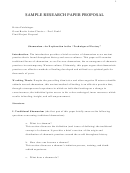Research Paper Proposal Sample
ADVERTISEMENT
Research Paper Proposal Sample
gis 140 / sec. A / early fall quarter 2007-08 / chang
A research proposal considers your overall topic ideas, your research question, your research process, and your
sources and scaffolds what the next steps will be for the project. Many disciplines require written proposals
before an experiment can be run, before a presentation can be made, before a seminar paper can be written.
Research proposals can vary in length depending on the scale and scope of the project at hand. However, in
general, all share certain conventions: framing of the project or contextualization or putting the project in
context or conversation with other research; a tentative thesis or claim or hypothesis; an approach or
methodology; target audience; tentative sources or references. Depending on the academic discipline, a
research proposal may include other required features.
For example, the following is a one-page seminar paper proposal for a literature class:
Michelle V.
Dr. Norman
EH 540
July 13, 2001
Paper Proposal: ‘You Looks Like Youse Yo’ Own Daughter’: Figuring (In)fertility
and Maternity in Their Eyes Were Watching God
Although critical responses to Hurston’s Their Eyes Were Watching God have focused extensively on
both sexuality and images of fecundity in the text, analyses that fully address fertility and maternity in
the novel are as strangely absent from the critical literature as the presumable fact of Janie’s
reproductive capacity is from the text itself. Unlike Nella Larsen’s roughly contemporary novel
Quicksand, Hurston not only seems to deny the notion that marriage is death for women, she also
disrupts the traditional association of marriage with pregnancy/childbirth (McDowell xxi). It is unclear
whether Hurston took this non-approach to Janie’s fertility in the novel as a means of disequating
marriage and childbirth, or simply because pregnancy and maternity did not figure in the story she
wanted to tell. However, the novel’s emphasis on fertility in nature and sexuality renders this textual
absence particularly problematic.
The proposed paper will begin with an examination of the ample fertility imagery in the novel. Janie’s
early conflation of fertility in nature, sexual desire, and marriage will be discussed, followed by the
role that sexuality plays in each of her marriages. Then, the textual absence of Janie’s reproductive
fertility will be addressed, as well as a discussion of whether this textual absence is evidence of the
novel’s failed realism, as some critics have suggested, or a byproduct of the idealization of the world
of the novel. A short discussion of the trope of textual absence or elision of conception and pregnancy
in the works of several African American women writers will also be included.
Although I have not yet fully formulated the theoretical framework I will use to account for the
problematic treatment of Janie’s fertility in the novel, the textual elements that I am planning to
discuss will be the extended mule metaphor/imagery (with its implications of sterility) and the
depiction of other maternal relationships in the novel (particularly those of Nanny and Leafy to both
each other and to Janie). Finally, I will relate the treatment of maternity and fertility in the novel with
the overarching theme of Janie’s quest for fulfillment/selfhood/voice/independence/embodiment.
Several extensive searches of the critical literature addressing Their Eyes have failed to reveal any full-
length articles addressing the textual absence of Janie’s fertility. The articles listed below address
various aspects of sexuality and sexual autonomy, marriage, and fertility imagery in the novel.
—From
ADVERTISEMENT
0 votes
Related Articles
Related forms
Related Categories
Parent category: Business
 1
1 2
2








